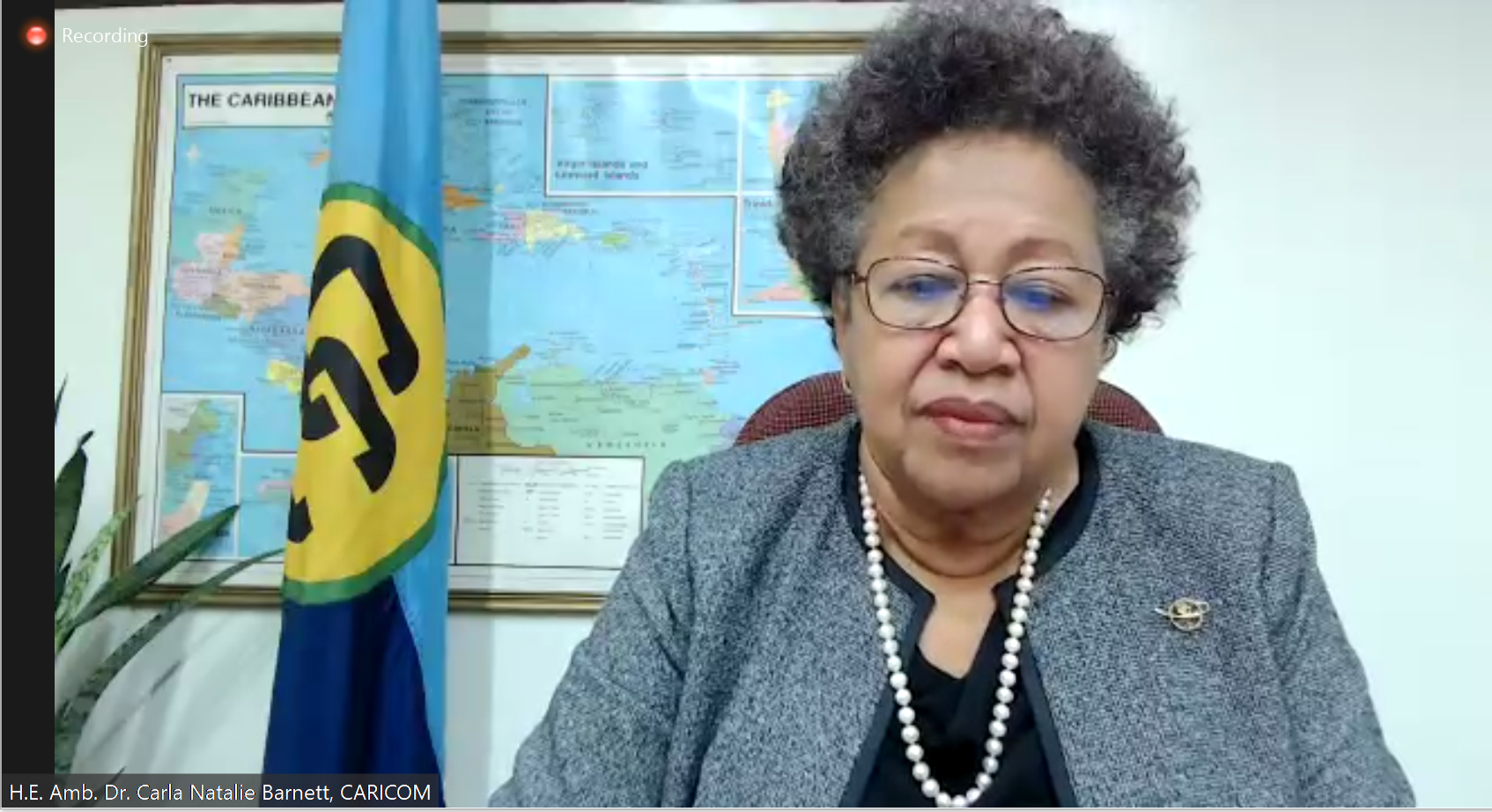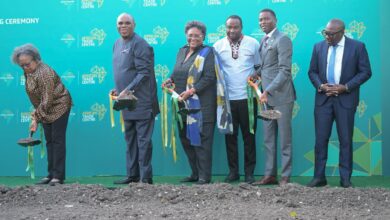- Your Excellency Roosevelt Skerrit, Prime Minister of the Commonwealth of Dominica;
- Dr. Cleopatra Doumbia-Henry, President, World Maritime University;
- Distinguished Delegates;
- Ladies and Gentlemen.
It is my distinct pleasure to address this first session of this series of Conferences facilitating dialogue on better ocean management in the Caribbean.
I commend the World Maritime University (WMU) for not only hosting this important event, but the excellent relationship it has shared with the Region in recent years. Likewise, the Nippon Foundation has been of major assistance in capacity building for ocean management in CARICOM, with many young professionals and government agencies in ocean affairs benefitting from a myriad of initiatives supported by the Foundation.
This ‘Closing the Circle’ Programme is the latest initiative, through supporting research and knowledge sharing, to address three major issues of the past decade relating to the health and well-being of the Caribbean Sea.
As this Region begins to emerge from the global pandemic, I am sure that everyone is pleased to have an in-person event like this after such a long time, particularly as we seek to bring attention to coastal and marine issues again.
The impacts of COVID-19 were widespread and severe, and we know them well. In addition to health, economic and social impacts, it took attention away from other regional and international crises, such as ocean health. Momentum towards a cultural shift in single use plastics and solutions for marine pollution gave way to important public health considerations, as temporary/single-use items and protective equipment became common-place in these past two years.
So now we are here in 2022, in beautiful Dominica, to rekindle momentum.
There are several pervading and troubling phenomena impacting the Region’s ocean space. Sea-surface temperature rise continues to harm coastal ecosystems and exacerbate storm conditions; plastics and other pollutants continue accumulating pressure on our oceans’ regenerative capacity; storms and other natural hazards like sargassum influxes continue to worsen impacts on coastal communities and low-lying areas. Annual storm impacts also reinforced the importance of improving the quality of ecosystem services, as they buttress our adaptive capacity to climate impacts and resilience to disasters.
The opportunity to exchange knowledge, lessons and progress on sustainable oceans management, to present findings of investigations, and collectively to craft solutions to the challenges in focus is both timely and necessary.
For Small Island and Low-lying Coastal Developing States (SIDS), long term sustainability implies that our recovery should be a green recovery from COVID-19, and this of course has to include blue aspirations. Before the impact of the pandemic, we recognised the tremendous potential of the ocean around us, in the services it provides, which in many cases remain untapped.
Within this context, Marine Spatial Planning (MSP) is widely accepted as the main tool to plan the orderly and efficient development of coastal and marine resources without jeopardy to the integrity of complex natural systems. As we develop marine spatial planning, with the involvement of the communities, process fosters inclusivity, gives voices to the marginalized, builds stewardship, and solidifies the pathways between science and policy.
Once deployed as designed, an MSP will be a valuable tool to reduce conflict over the use of resources, curtail overlapping cumulative pressures, provide an early prospectus for investors, and a strategic guide for sustainable development of the marine space and its resources.
This type of collaboration fostered in Marine Spatial Planning is essential to combat the issue of marine debris and marine plastics plaguing the world’s oceans. This is particularly distressing to us in the Caribbean Sea who are highly dependent on coastal tourism. This issue reflects the results of our system-wide, post-industrial relationship with nature, whereby production processes have been developed with little regard to the cumulative impacts of both our production and consumption habits globally.
Quite simply, the world at all levels needs to ‘break up with plastics’ as the tagline goes. We have grown comfortable in a reality where plastic packaging is discarded mere minutes after purchase, but persists in the environment for hundreds of years.
Markets are flooded with cheap gadgets with no longevity, modularity or repairability, marketed and designed with short-term built in obsolescence with the expectation of quick replacement with the new successor model. The alarming impact of this amassing of waste on marine life has, thankfully, come to light.
Globally, there is a transition taking place that is seeing some streamlining of production to begin to address the crisis of plastic pollution. The transition, however, requires a complete cultural shift beyond production to include packaging and consumer choices – closing the circle in every aspect of production.
CARICOM Member States recognized the fragility of island resources in prescribing environmental protection and sustainable resource use in the articles on trade and economic development in the Revised Treaty of Chaguaramas. This was despite the notions of circular economy not being widespread at the time.
The result of streamlined production and circular economy is that fewer plastics will enter waste management systems, and escape into drains and waterways flowing into our already vulnerable coastlines.
As you know, the classical vulnerabilities of SIDS hit home in waste management: limited physical space, somewhat isolated geographies, limited to no economies of scale for waste as a resource, and limited fiscal and technical capacity for comprehensive waste management investment. The Caribbean has been experiencing severe challenges in implementing comprehensive waste management over the years.
Our limited capacities were thrown into sharp relief with the periodic inundation of our shores by sargassum seaweed over the past decade. Sargassum has hammered our coastal tourism in the Region. Even as the COVID-19 pandemic almost overshadowed the complex issue of sargassum inundation in the past two years, its significance has not diminished.
The impacts of sargassum are well known to this forum –
- The sheer volume smothered nearshore reefs and beaches;
- Coastal erosion was exacerbated on sandy coasts;
- Wildlife, including cetaceans and turtles were strangled and suffocated;
- Decaying seaweed caused public health concerns in coastal communities with sulphurous odours,
- Fisheries, both nearshore and pelagic were negatively affected;
- The impact on tourism was significant;
- The logistical nightmare and cost of clean-up was daunting.
Ladies and Gentlemen, even as the Caribbean Sea is sometimes known as the lifeblood of the Antilles, the sargassum inundation is surely symptomatic of an ailing ocean, pressured by land-based sources of pollution and climate change.
Paying attention to the signs, and acting as responsible environmental stewards, we did not just dispose of the seaweed, but embarked on a suite of research and investigations in the Region to understand driving factors, origins and solutions to the challenge. Bodies of knowledge began to form from various quarters, including the Caribbean Regional Fisheries Mechanism (CRFM), the University of the West Indies (UWI), the United Nations Educational, Scientific and Cultural Organization (UNESCO), the Food and Agriculture Organisation (FAO) and the United Nations Environment Programme (UNEP), to name a few.
The Region now has a greater understanding of the sources and oceanographic mechanisms for the proliferation of sargassum. We have guidelines for proper removal and disposal. We have a sense of its potential uses and strategic options for product development and commercial application.
In closing the circle on sargassum, youth innovation and Caribbean ingenuity combined to drive the transition of sargassum from a hazard and a nuisance to a resource with several commercial applications at various scales emerging in recent years. Applications range from agrochemicals to cosmetics to fertilizers and even potential biofuel applications. Some Member States have also taken a holistic industrial engineering approach to find solutions suitable to the scale of the challenge. You will no doubt learn more about some of these initiatives over the course of the two days.
Regardless of the challenges faced or opportunities presented, science and technology remain key supporting pillars for the conservation and sustainable use of any natural resource. Optimal use of natural resources can only occur by informed decision-making, fed by a comprehensive understanding and knowledge of that resource.
As we continue our journey towards accelerated investments and developments in blue economy, there must be a supporting parallel track of knowledge and capacity building, through science and technology at national and regional levels, to ensure responsible, efficient, evidence-based decision-making. The broad elements of which are:
- Routine monitoring of coastal and open water environments, including both biological and physical oceanography;
- Robust marine surveillance for effective security and sovereignty;
- A research agenda that is needs-based and cyclical, while still promoting a culture of curiosity and innovation;
- Regular reporting that is credible, timely and salient on the state of marine resources, their ecosystem services and associated sectors;
- Platforms, such as this conference for knowledge exchange as part of a multi-modal science to policy interface; and
- Continuous capacity building and awareness at all levels, including sensitization of decision makers and donors.
In addition to science and technology for knowledge-building and better decision-making, greater technology use is critical for driving innovation and finding solutions to challenges.
Maritime work is inherently risky, and even more so in the multi hazard reality of the Caribbean. The use of technology for communication and early warning has been transformative in Caribbean society, and fisherfolk benefitted from this application of technology. Back in 2018, fisherfolk gained access to tailored early warning and information on sea conditions through the Fisheries Early Warning and Emergency Response System or FEWER app. This was developed through the support of the Inter-American Development Bank and implemented by partners in the Region, such as the UWI and CRFM in partnership with the ‘ICT4Fisheries Consortium’.
Likewise, in response to unpredictable sargassum influxes, researchers have collaboratively developed early warning products for coastal communities, tourism planners and fisheries to furnish data for decision-making.
The utility is clear, but major investment in science and technology is a severe challenge for developing states globally. Investment in both technology upgrades and supporting frameworks for innovation is particularly low in SIDS, reinforcing the need to maximize the provisions of parts XIII and XIV of United Nations Convention on the Law of the Sea (UNCLOS) pertaining to international cooperation on Marine Scientific Research (MSR) and transfer of marine technology, respectively.
Governments are urged to leverage bilateral relationships to facilitate meaningful technology upgrades and to take full advantage of the marine research conducted in our waters by Third States, provided for in the Convention on the Law of the Sea, as a strategic means of improving capacity and our understanding of our ocean.
I look forward to receiving an update on how the Caribbean countries are faring with leveraging Marine Scientific Research requests from Third States. Perhaps also, the Organisation of Eastern Caribbean States (OECS) Commission will share its experiences in strategically leveraging such requests in the OECS, as part of the Eastern Caribbean Ocean Policy.
I am sure there will be exciting presentations and stimulating discussions by researchers and change makers, at this Conference on closing the circle. It is through knowledge exchange that we can accelerate the replication of good ideas and transformative solutions and learn from each other’s experiences.
I wish you a very productive two days of learning and sharing knowledge.
I thank you.






